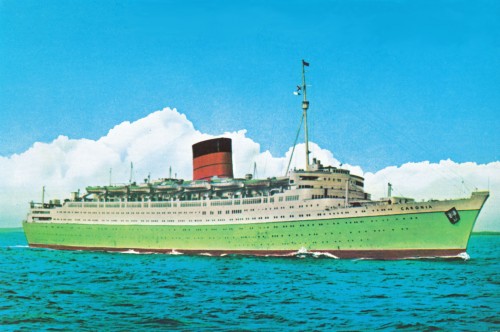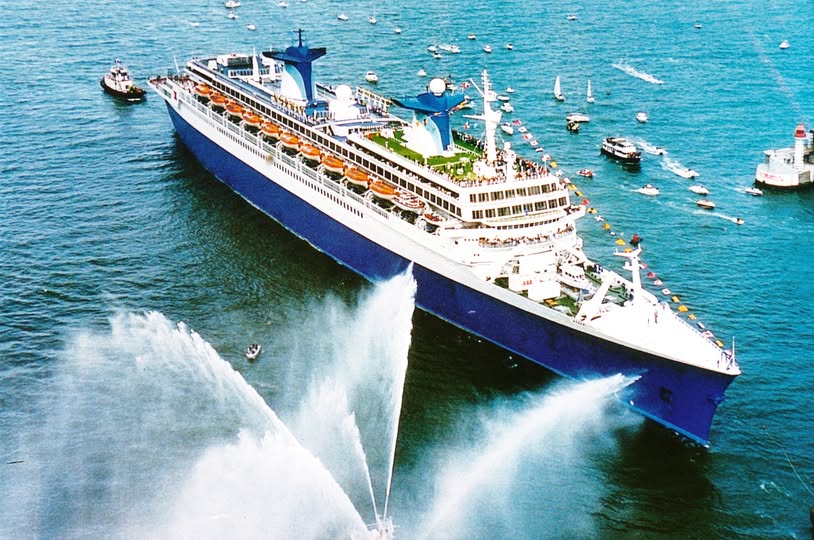Caronia is one of the first luxury cruises ships of the postwar era. The (British) cruising market was divided mainly between three vessels at the time, for budget cruises the Pacific Steam Navigation Company and later Union Castle Line operated the Reina del Mar, for the middle class there was Royal Mail’s Andes and for long (expensive) cruises Caronia was introduced by Cunard in 1948. On Oct 30 1947 she was launched from John Brown’s Shipyard on Clydebank, Glasgow by HRH Princess Elizabeth as her last public engagement before her marriage with Prince Philip. Her first trip was a transatlantic voyage to New York.

She is credited for being the first dual purpose vessel, as Caronia was planned at first to be a transatlantic liner alongside the Mauretania, but the board of Cunard changed their minds and had her built as a dual purpose vessel with both crossing and cruising in mind. At the start of her career she only cruised during the winter, but after 1952 she would cruise all year apart from August and September when she would make transatlantic crossings.

The Caronia made her maiden voyage on January 4th, 1949 from Southampton to New York, via Cherbourg, and during the winter did a series of cruises to the West Indies and South America.
It was not until January 1951 that she started out on her first world cruise which called at over 30 ports. In December 1952, during the ship’s annual overhaul at a Liverpool shipyard, there was a fire but it was quickly put out and didn’t cause serious damage. For Queen Elizabeth II’s coronation ceremony during the summer of 1953, Caronia ferried American visitors over to England. Later, she was used as a floating hotel as all land based hotels were booked to capacity.


At the end of 1956, the ship was fitted with air-conditioning throughout.
Caronia had a club-like atmosphere, passengers asked for the same cabin steward and ding-room waiters, who still knew their names and preferences. Her beautiful art deco interiors made her one of the most luxurious cruise ships of her time. Passengers were loyal to Caronia, kept returning year after year, hosting parties in their quarters. Some of them didn’t leave at all, one lady stayed onboard for 14 years! She was highly profitable to Cunard and on her passenger list many of the rich and famous form the UK as well as from the States were present. Caronia became most famous, , for its world cruises. If you could afford it, Carionia was THE vessel to sail on. She was nicknamed The Green Goddes (it is said this came from by the people of Liverpool because her livery resembled that of the local trams, also known as “Green Goddesses”.) as she was painted in four shades of green to emphasize her being operated as a cruise ship. Cunard later had all members of their fleet engaged in cruising painted this way, while those in transatlantic service kept their black hulls and white superstructures. Carionia was instantly recognizable as apart from her exterior color scheme, by her large single mast and huge very wide single funnel, the widest funnel ever to go to sea it is said. And she was the first ever Cunard vessel with a permanent an outdoor pool.

Caronia had – like almost every ship does- her mishaps. For example in April 1958 she struggled to leave the port of Yokohama in strong winds and hit an antique lighthouse which she completely destroyed. She needed to be repaired immediately. Fortunately, the US Navy came to the rescue and allowed the ship to use Yokosuka dockyard in their naval base. Afterwards Cunard was held liable for the damage which resulted in them paying a large amount for compensation.

But the the career of Caronia came to and end as other lines introduced more modern ships, having more facilities to offer to discerning cruise passengers. In October 1965, in an effort to match the Caronia to the competition she was refurbished at Belfast. A large lido deck and open air swimming pool were added and her aft decks enclosed with glass screens. But her passenger loads steadily decreased and in 1967 for the first time she did not turn a profit to her owners… Cunard decided she needed to be withdrawn the following year. She was sold to a Yugoslavian company, Domus Turist which planned to operate her as a floating hotel at Dubrovnik. This deal fell through and on 24th May 1968 she was resold to a Panamanian company, Star Shipping. Renamed Columbia she sailed to Piraeus to be refitted.

Andrew Konstaninides bought out his fellow board members of Star Cruise and now had full ownership of Columbia which he renamed Caribia. Her new owner finished her overhaul and finally, she left New York on February 11th, 1969 on an inaugural 14 day cruise. Despite complaints from passengers she left on a second cruise on February 28th. During this cruise a steam pipe burst, killing one crew member. Now, without power, she was adrift. After 20 hours temporary repairs were made and the ship returned to New York. Her planned cruises were cancelled, she remained docked at New York.


Her owners went bankrupt. She was sold to a Turkish business man who could not raise the money for a refit and so Caribia spent the next five years languishing in New York. Finally in 1974 she was sold to Taiwanese ship breakers and left New York on 27th April for Kaohsiung but never got there. At first, problems began when she started listing near Honolulu but, after being repaired, she could continue. On 12th August Caribia and her tug, the Hamburg, had to fight a tropical storm off Guam. The Hamburg’s generator failed close to Apra Harbour and it was decided to cut the towline. The Caribia drifted towards the breakwater and it seemed she would just drift into port, but she didn’t make it and crashed into the breakwater. Caribia broke in half on 14th August, after being pounded by stormy seas. Now she had to be salvaged in situ as she was blocking the port entrance to other ships. There was a complication however, she was lying beside a former naval vessel, which still contained tons of ammunition and explosives. This dangerous cargo had to be removed first before scrapping could begin.
After a relatively short life of 25 years of which she had been active for only 19 years, the former Caronia, setting new standards when she was introduced, was gone….



